|
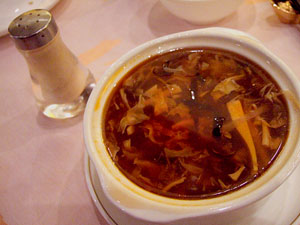 |
|
Dominic Armato |
|
UPDATE : Sichuan Garden has closed, and a redesigned Peking Garden remains.
When I consider the fact that I've spent well over 100 nights in Hong Kong, it's astounding how little I've actually seen here.
It's something I always lament. I get to Hong Kong anywhere from 4-8 times every year, and they're all surgical strikes. A typical visit for us is two consecutive 12 hour days in Shenzhen (just across the border to the north) and three nights of sporadic sleep when the office back home isn't calling, bookended by 23-24 hours of transit in either direction. Occasionally, we'll get a day off, but when that happens we're so bleary from the long hours and the jetlag that it's all we can do to keep from sleeping the entire day, much less find the energy to get out and about to explore. It's not something I'm proud of, but it's an unfortunate reality of the schedule we have to maintain. With such brutal trips, it's no wonder that we're creatures of habit when traveling to China. We stay in the Conrad on the island, perched atop Pacific Place, an upscale mall that gives you no hint whatsoever that you've left the western hemisphere. It even houses an establishment named Dan Ryan's Chicago Grill, which is disconcerting on a number of levels, not the least of which is the kind of creepy unease you'd expect from visiting a theme restaurant based on your hometown. In any case, there is an assortment of competent international restaurants housed within Pacific Place, and we've pretty much tried them all. Some of my compatriots can only handle so much Chinese food before it starts to get tiresome. And admittedly, when the factory rolls out the red carpet and stuffs us with an obscene amount of food day after day, I have to consider the possibility that I couldn't do more than a week before I needed to decompress with a simple sandwich or a plate of pasta. But when we come to China, it isn't a marathon, it's a sprint. As such, when we aren't dining on the other side of the border, when my traveling companions aren't desperately in need of something non-Asian, and when there isn't time or energy to strike out in search of new restaurants, I fall into Peking Garden and Sichuan Garden whenever possible.
|
|
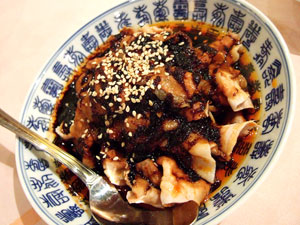 |
| Dominic Armato |
|
Peking Garden and Sichuan Garden are a pair of restaurants that are run by Maxim's Group, Hong Kong's equivalent of Chicago's Lettuce Entertain You. They're sister restaurants, each taking up half of the same space and sharing a common kitchen. I remember a time when you'd choose whether you wanted to eat at one or the other, but at some point the management must've realized it was pointless trying to keep the two segregated, and now they don't even offer you a choice. They'll plunk you down wherever it's convenient and drop both menus on the table. It's not as inappropriate a combination as you might think, since the Sichuan menu seems more like Sichuan by way of Canton to me. China is a mind-bogglingly enormous country, and there are so many unique regional cuisines that I've only barely scratched the surface. But with my limited experience I've come to the conclusion that while PG/SG's dishes aren't necessarily authentic to their home region, they are authentic to their home country. To put it another way, I think that getting a Sichuan chicken dish at PG/SG is sort of like getting a pasta Bolognese in Rome. Do the Romans prepare it just like they do in Bologna? Not exactly. But it's still a damn fine pasta, and close enough to the original that it can't be derided for being an ever-so-slightly loose interpretation. In any case, authentic or not, every dish I've ever had at PG/SG... and I've had quite a few... has been excellent.
|
|
|
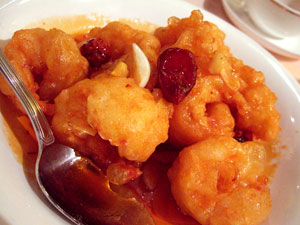 |
|
Dominic Armato |
|
If I had to summarize, I'd describe the restaurant's style as a clean but casual amalgam of Chinese cuisines typefied by spotless execution and potent, beautifully balanced flavors. PG/SG was my first meal in China, and it's the perfect eye-opener for someone who's never had the opportunity to see beyond the Americanized version. This isn't what you get back home, but they also aren't throwing the snakes and scorpions and chunks of congealed blood at you just yet. You can graduate to that later. It's Chinese that's safe for first time visitors, and I absolutely don't mean that in a derogatory manner. For the most part, the menus are filled with dishes that, while regularly butchered in the States, will still be familiar to those who haven't spent time in China. A perfect example is Hot and Sour Soup. For those who enjoy it at home, PG/SG's version will seem entirely familiar. Just better. It sidesteps all of the common pitfalls. It isn't bland, it isn't brimming with cornstarch, and rather than being hot
or sour soup, it's actually hot
and sour soup, with chinkiang vinegar subtly but firmly holding down the sour half while chile oil and white pepper tag team the hot half.
|
|
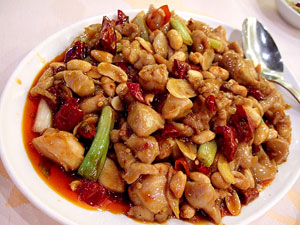 |
| Dominic Armato |
|
Another favorite appetizer is their Sliced Pork in Garlic and Chili Sauce. It's a small pile of very tender, moist slices of carpaccio-thin cooked and chilled pork, swimming in a sweet and slightly spicy oil with heavy soy, garlic and sesame components. It's a bold and succulent dish that challenges the western notion that all Chinese dishes are stir-fried, deep fried or steamed. From there we usually move on to one of my favorite dishes anywhere, their Deep-Fried Prawns in Sweet-Sour and Chili Sauce. It's a sweet-sour that demonstrates the folly of the goopy, ketchupy glop that's frequently found on chunks of lean pork loin in the States. The sauce is a very light syrup with some characteristics that almost resemble a liqueur. It's potent, and it swings more towards the sour end of the spectrum, then punches you with the aromatic trio of chili, garlic and ginger all at once. It's almost like a Thai dish in its explosiveness, and it's at or near the top of my list of restaurant dishes I'd like to reverse-engineer.
|
|
|
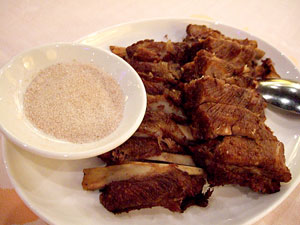 |
|
Dominic Armato |
|
From here, we move on to the
recently mentioned Sauteed Diced Chicken with Nuts in Chili Sauce. You'll forgive me for taking a moment to wax poetic here, but this is a dish that made my
top ten of 2005, and it deserves detail. This is a truly spectacular chicken dish. It's a very common blend of Sichuan flavors, but turned on its head somewhat. In traditional fashion, it's an oily stir-fry that combines chili oil, dried chiles, ginger, garlic, vinegar, (I think) shaoshing and
huajiao, also know as sichuan peppercorn. It's no small accident that this made my top ten in the year that huajiao became one of my pet ingredients, but the appeal of the dish goes far beyond that. In Sichuan cuisine, the "ma la" thunder and lightning combination of spicy and tingly is most often typefied by the combination of chile peppers and huajiao. If you've ever had an abusive Ma Po Dofu, you're familiar with ma la. But while I love the fire, in this dish it shares the stage with the sour. It's almost a sophisticated mellowing of the aggressive Sichuan I've come to know, and it's expertly done. This is a multilayered dish with balanced flavors that I only dream of duplicating. And the choice to use only dark meat is both the correct one, and one that would rarely be made in the States.
|
|
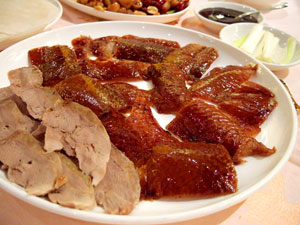 |
| Dominic Armato |
|
For me, a Chinese meal isn't complete without big chunks of pork, and the Spiced Fried Spareribs are another favorite. Coming from the United States, you'd be forgiven for thinking this was the first time you'd ever tasted real pork, largely because you'd be right, but that's another rant for another day. Here, the ribs are coated with some type of dry spice blend and deep-fried, then sliced and served with a fine seasoned salt for dipping. The meat is both minimal and delicious. The seasoning is present, but plays only a small, unobtrusive supporting role. This is pork with character. The outside isn't a dense, tough chew like American BBQ, but is instead very light and crispy. The meat inside is tender, but it offers resistance. The meat falls from the bone, but to consume it requires a certain amount of immensely pleasureable chewing. Being very lean, it's in stark contrast to the ultrafatty Chinese pork that I've come to adore, but even in this state it has more pork flavor than almost anything I get stateside. Given the texture, I'm quite certain it's cooked before it hits the deep fryer, but I have no idea what form this par-cooking takes.
|
|
|
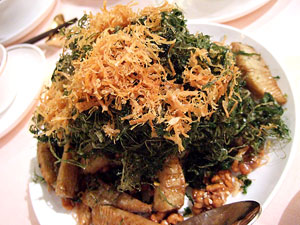 |
|
Dominic Armato |
|
Of course, if it isn't a law that all Peking-style restaurants must do a phenomenal Peking Duck, it should be. But in any case, these folks are in compliance. It's a no-frills preparation that doesn't go through the extra steps of creating stir-fry and soup and what have you from the rest of the carcass, but instead focuses on the essence of Peking Duck, which is the crispy, fatty, lacquered skin. You have the option of receiving your bounty either in sliced form, with a little strip of skin along the edge of each slice of meat, or the way I prefer it, as seen here, skin and meat separate. With the latter, you're more able to get a good mouthful of the incredible skin, which obviously makes it the correct choice. Another of our favorites is something the likes of which I've never seen in the States. Their Deep Fried Crispy Shredded Conpoy, Walnut, Bamboo Shoot and Salt Cabbage is, I suspect, not what the USDA has in mind for the fruits and vegetables section of their venerated pyramid. But surely, if they were aware of such a dish, an exception would be made for its exceptional taste. It's a dish that's as much about texture as flavor, though the latter is certainly no slouch. The entire dish is fried, and as such is rather crispy, though each component is crispy in a different fashion. The cabbage and bamboo are both heavily salted, and the
conpoy (dried scallop) brings a briny flavor, but the salt is balanced somewhat by the crispy candied walnuts sitting at the bottom of the dish. The entire thing has the feeling of vegetables turned into a sophisticated version of junkfood, appealing to snacky sensibilities.
|
|
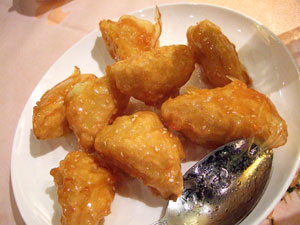 |
| Dominic Armato |
|
And, speaking of snacky sensibilities, we have a favored dessert as well. Their Apple Fritters are brought to the table as large slices of apple bathed in a hot caramel, fresh from the wok. While tableside, they drop the sticky, sizzling caramel apples into a bath of ice water or... if you prefer... cream soda, which instantly hardens the caramel, turning it into a light and crunchy candy crust. The slices are then turned out onto a plate to be consumed, hot and crispy. The apples themselves have been slightly cooked with the caramel, mostly raw, but just slightly softened on the edges, which mellows the tartness and accentuates the sweetness. Personally speaking, while I understand the appeal of the cream soda, I prefer the plain water bath. The apples and caramel both have a very natural-tasting sweetness, and while the cream soda adds a little more complexity to the flavor, to me it also adds a touch of a sickly sweet carnival treat feel. It seems less like something that's coming from a wok, and more like something that should be eaten alongside cotton candy. It's worth noting that the difference is rather subtle, but at the end of a fantastic Chinese meal, authentic or no, I'm not prepared to shatter the illusion with carny food.









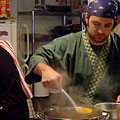
Comments